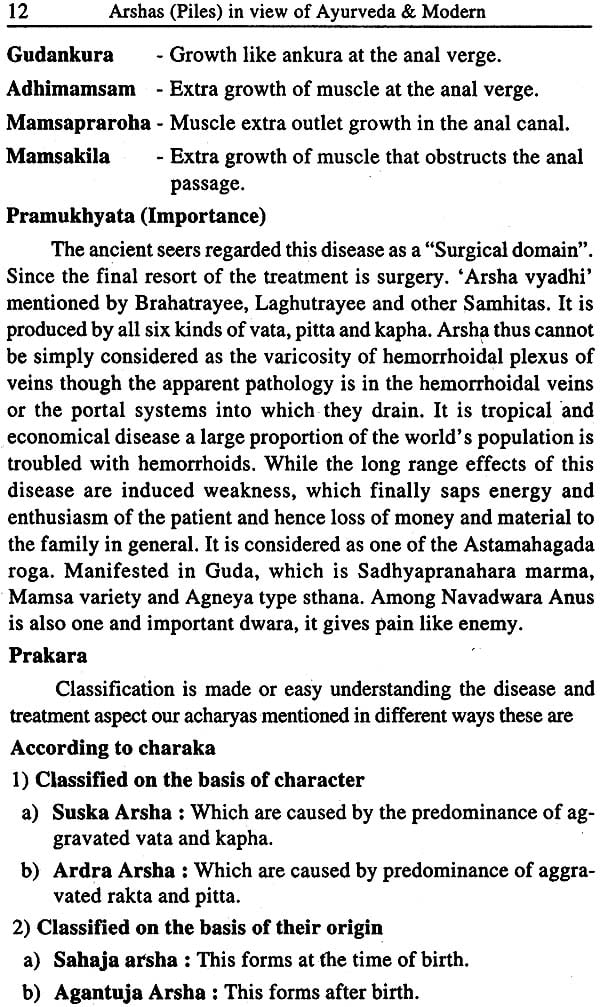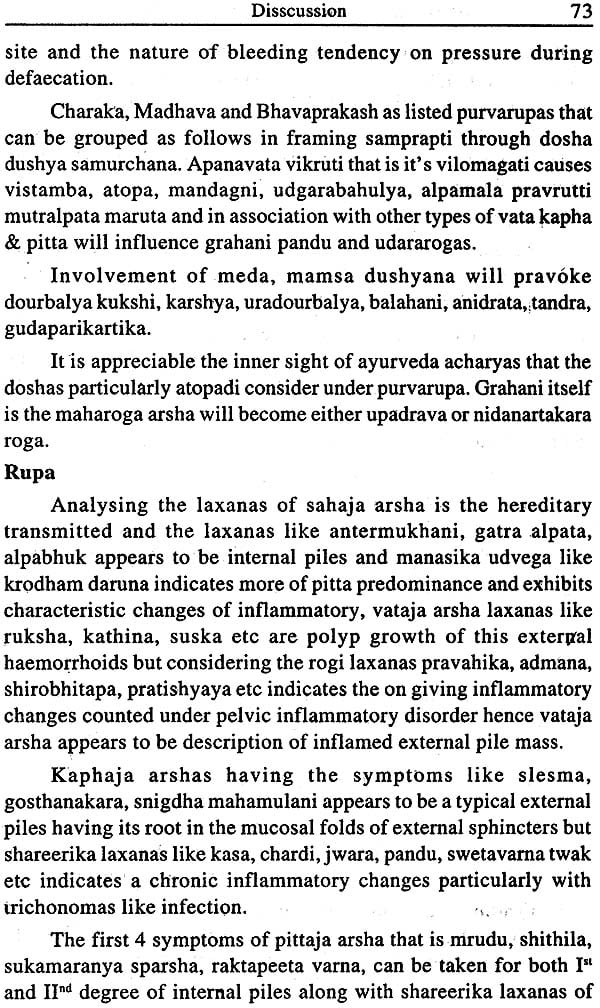
Arshas (Piles) in View of Ayurveda and Modern
Book Specification
| Item Code: | NAN796 |
| Author: | Dr. Nagesh Gandagi and Dr. Shubhangi Patil |
| Publisher: | CHAUKHAMBHA ORIENTALIA, Varanasi |
| Language: | English |
| Edition: | 2017 |
| ISBN: | 9789386660619 |
| Pages: | 105 |
| Cover: | Paperback |
| Other Details | 8.5 inch X 5.5 inch |
| Weight | 110 gm |
Book Description
Dr. Nagesb Gandagi
B.A.M.S. from G.U.G. Gulbarga, M.D. (K.C.) from R.G.U.H.S. Bangalore, Ph.D. (K.C.) from M.U.H.S.Nashik., C.C.C.R. From S.C.H. Pune., P.P.c. From S.G.A.M. Nashik., Delivered various Guest Lectures, Written Articles in National and lnternational Index Journals, Received prizes in competition related to Ayurveda, Staff editor of "NOUNKU" book, Editor of "Journal of Ayurveda" official publication of M.P. Medical Science University. Radio Talk on diseases, Attended various State, National and International RoTPs, CME, Conferences, Seminars, Workshops, Paper and Poster presented in Conferences, Published Books, Currently working as a Vice Principal, Professor and Senior Physician, P.G. Department of Kayachikitsa, at Pt. Dr. Shivshaktilal Sharma Ayurveda Medical College and Hospital, Ratlam, Madhya Pradesh.
Dr. Sbubhangi Patil
B.A.M.S. from V.A.M. Arnravati., M.D. (R.N.) from S.A.M. Nagpur., C.C.C.R. From S.C.H. Pune., P.P.C. From S.G.A.M. Nashik., Received Best Guide Award for Bharat Scout and Guide from Governor of Maharashtra, Received Best Guide A ward for Bharat Scout and Guide from President of India., Delivered Guest Lectures., Written Articles in National and International Index Journals., Editor of "Journal of Ayurveda" official publication of M. P. Medical Science University., Received prizes in competition related to Ayurveda., Radio Talk on diseases., Attended various State, National and International RoTPs, CME, Conferences, Seminars, Workshops., Paper and Poster presentation made in Conferences. Published Books.Currently working as a Professor and Senior Physician,Department of RogaNidanaevumVikritiVigyan, at Pt. Dr. Shivshaktilal Sharma Ayurveda Medical College and Hospital, Ratlam, Madbyapradesh.
FEATURES OF THIS BOOK
• Complete knowledge of Arsha (Piles) according to Ayurveda and Modem.• Comparisons in between Ayurveda and modem related to Arsha (piles).
• Discussions on various concepts of Arsha (piles).
• Practical oriented conclusions after discussion on various factors of Arsha (Piles).
• Special Case Perform a of Arsha (piles) case.
• This book is helpful for Teachers, Physicians, P.G. and U.G. students.
Ayurveda has immense potential to help in the solution of many challenging and unresolved problems of medical science. Ana-rectal disorders are progressively increasing in the society. By looking into the history one can understand that great saints like adishankara who revived the Vedic literature and famous rulers like Napoleon suffered from this disease. Arshas is considered as one of the Mahagada which occurs at marma pradesha. Few important causes out of a number of them are sedentary life style, irregular and inappropriate diet, prolonged sitting and psychological disturbances like anxiety and depression etc. these causes derangement of jatharagni which leads to constipation and other associated symptoms. It has been mentioned in ancient classics, that impaired jatharagni produces all kosthagata rogas hence, arsha is also one. A constipated bowel is the devil's workshop. Constipation increases the back pressure into haemorrhoidal veins to produce piles. The fast food culture has again worsened the condition as these foods are devoid of fibre. The perianal skin is one of the most pain sensitive region in the body due to rich nerve endings. By the above causes even a mild form of disorders can produce great discomfort to the patient. It is observed that in the initial stage of the disease, most of the patients specially female avoid consulting to the doctor and explaining their problems because they feel ashamed. This makes bigg in coming days. In Ayurveda chikitsa of arsha mentioned in Bhishajya Chikitsa, Kshara Chikitsa, Shastra karma, Agni karma and Raktamokshana etc. The eminent surgeons and proctologists expresses that some complications arises in pre and post operative stages.' Apart from surgery the latest techniques such as cryosurgery, rubber band therapy as well as infrared coagulation therapy etc are described. The number of techniques shows that the lack of universal acceptance of particular treatment, to avoid surgical complications and to achieve good results for arshas disease.
Peoples have now turned their faith towards Ayurveda to resolve their problems. Due to this changed vision, the demand of Ayurvedic proctologist has suddenly been increased manifold. Overall, we have seen the miraculous effects of Ayurvedic drugs particularly in the management of arsha. So, we felt it is beneficial to include the knowledge regarding Ayurveda and Contemporary sciences under one book for students, clinicians, academicians, researchers, and practioners. There may be some mistakes escaped in the book because of being it a manual work and to error is in human. It is requested to forget them and grasp positive as much as they can. It is further requested to communicate their viable suggestions so that the same could be incorporated in the revised edition of the book. I sincerely hope that this book will be useful to you.
Arsha is a kind of disease which is most unkind towards mankind. By looking into the history one can understand that great saints like adishankara who revived the Vedic literature and famous, rulers like Napoleon suffered from this disease. Adhishankara who drank the ocean of knowledge as easily as 1/6th palm of one's hand. In one of this hymn he prays to God to relieve him of this condition. It is said that king Napoleon would have won the battle of Waterloo, if he did not suffer from acute Arsha.
Arsha incidence increases with advancing age, at least 50% of people over the age of 50 years have some degree of haemorrhoidal symptoms. 5% of general population suffers from haemorrhoidal symptoms (Fromm D). In 2000, incidence of internal haemorrhoids was 72% (Davis, Fostet and Gamelli). Recent statistics reveals that irrespective of age, sex, socio-economics status, people suffer from piles. Now a day every person suffered from anyone of the complaint of piles during their life time. Haemorrhoids or piles are dealt rationally under the concept of arshas find in almost all ayurvedic literature which deals with diseases and its treatment. Since the time immoral, efforts have been made all over the world to combat the condition through different modalities of treatment, but not all of them have been uniformly successful. The prime etiopathogenic factor of arshas is mandagni i.e. hypofunction of digestive enzymes, which in turn leads to constipation, prolonged contact of accumulated mala or excretory material to gudavalis cause development of arshas. The food habits and life styles of modem man also added to the increase in rate of incidence of arshas. Piles pierce through may appear as a simple haemorrhoidal masses that descending. Physician takes wholestic look as to its causes. The physician is worried whether there is any hepatic obstruction causing plethoric pressure in the portal system, or whether the supporting muscularies mucous, in anorectal region is having any protein deficiency as to sage and thus cease to provide support to the haemorrhiodal vessels or whether there are any congenital exuberant fibrous bands occurring near mucocutaneous area at anorectal region causing compression over the haemorrhoidal vessels to formation of pile or whether there is any prostatic enlargement in elderly males, causing pressure over the anorectal region or pregnancies in women contribute to pressure phenomena leading to pile formation or habitual constipation, long standing postures or insufficient deistic fibre contain may also acts as a contribute factor for pile formation.
As per Acharya Sushruta the doshas by their aggravating causes, dislodges from their normal seats alone or combined with other including the rakta, reaches the maladwara (marga) and causes the vitiation of gudavalis resulting the production of mamsankuras, especially in mandagni persons. Ayurveda propounded a varied chikitsa for arshas. It. is medicinal as well as para surgical treatments are prevailing even today. The management of arshas under four headings, those ire oushadha chikitsa, ksharachikitsa, agni karma and shastra karma. The eminent surgeons and proctologists expresses that some complications arises in pre and post operative stages. Apart from surgery" the latest techniques such as cryosurgery, rubber band therapy as well as infrared coagulation therapy etc are described. The number of techniques shows that the lack of universal acceptance of particular treatment, to avoid surgical complications and to achieve good results for arshas "disease. Even some of the local and external applications have not brought out and which gives fruitful results, there is a need to find out a simple effective, economical and most suitable internal medicine by which the patients can move freely. In this present era more number of patients are interested or inclined to take oral medicines rather than surgical procedures because they knew that surgical procedures may give raise one or other complications.
| 1 | Introduction | 1 |
| 2 | Basic disease Review | 3 |
| i | Guda Rachana/anus anatomy | |
| ii | Guda Kriya/Anus Physiology | |
| 3 | Disease Review | 11 |
| i | Shabdha Artha/Defination | 11 |
| ii | Nirukti/Derivation | 11 |
| iii | Parayaya/Synanyms | 11 |
| iv | Pramukhyata/Importance | 12 |
| v | Prakara/Types | 12 |
| vi | Nidana Panchaka/Diagnosis Factors | 15 |
| vii | Upadrava/Complication | 35 |
| viii | Sadhya Asadhyata/Prognosis | 37 |
| ix | Arsha Rogi Pariksha/ | 39 |
| x | Guda Pariksha/Anal Examination | 39 |
| xi | Sapeksha Nidana/Differential Diagnosis | 40 |
| xii | Chikitsa Vivechana/Management | 42 |
| 4 | Disscussion | 69 |
| 5 | Conclusions | 80 |
| 6 | Clinical Proforma | 82 |
| 7 | Bibliography | 95 |









